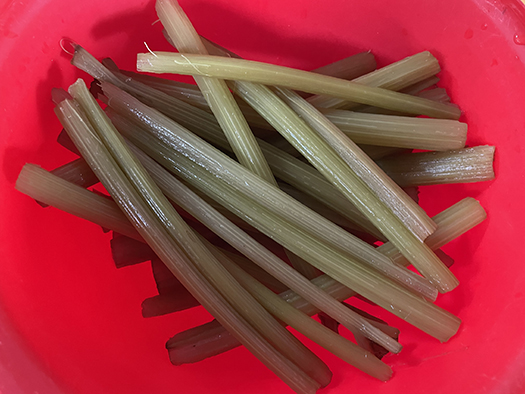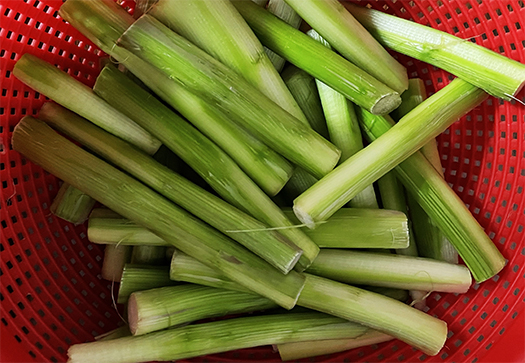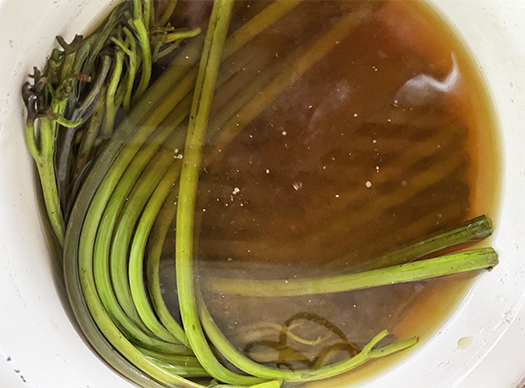


ここのところ東京国立博物館の法隆寺宝物館展示での聖徳太子絵伝の記事に集中していました。絵伝ということでわかりやすく、1000年の時を超え共有認識を得られることでちょっと過熱気味(笑)。
ということでクールダウンで本日は中休み。
6月も半ばになってきて北海道は天国に一番近い島状態。クルマで自然豊かな環境の中を走るのには最高の季節であります。そういう「野趣」を満喫させてくれるのが各地で露地物として出荷される山野菜類。
ことしは食習慣改善の取り組み、真剣に実践中なのでその食材として、アスパラ・フキ・ワラビなどから目が離せなくなっております。豊富な食物繊維摂取がいかに健康に大事か、身を以て知らされている。
カミさんもわたしと完全に同じような食習慣改善に取り組んでいるので、こういう食物繊維類の収集、それもなるべく新鮮で香り高いものをと各地をいっしょに走り回っている。
ことしは例年以上にヒグマの出没情報が多くなっているので、山菜類の捕獲には困難が伴っていると思われますが、各地の「道の駅」などでは毎週土日など、豊富に山積みされています。そのご苦労に感謝しつつ、購入させていただいています。
わが家の場合は、アスパラはシンプルに茹で上げて食し、その他の山菜はコンブ・鶏肉などでしっかり出汁を取った煮浸しとして基本食材化。ごはんを制限しているなかで、むしろ主食化しつつある。
でもそうすると自然からの贈り物なので、下処理作業が不可欠になります。

写真左はフキを適当な長さに切った後、板の上で塩を振って「板ずり」処理したあと後、茹で上げたフキから繊維スジを取った様子。一方、右側はアスパラの、ちょっと外側繊維が強烈な格安「ハネ品」(笑)でして、こちらはピューラーで外側を丹念に剥き上げたものの残骸の様子です。
どちらもホント、手間暇がかかるのですが、こういう作業に没頭するのもなかなかいい(笑)。その単調な作業に打ち込むことでいわゆる三昧のような没入感に満たされて、自然と向き合うようなそういった満足感に包まれる気がするのですね。
北海道の土の香り、山の空気感が凝縮された香りが身体感覚と共振するかのよう。
一方で旬の海のお魚さんたちも馴染みのお店で仕入れてきて、こちらも三枚下ろしさせてもらう。すっかり余市の新岡商店さんで見よう見まねさせていただいてから、週末の調理作業の定番化してきている。これまでは口に入れるしか縁がなかった魚さんたちをそのお姿を確認させていただいてから、謹んで解体させていただく。捌くという調理行為にはなにか、人間の本然を揺さぶるような部分を感じます。
なんともありがたい、天国にいちばん近い北海道の季節であります。
English version⬇
Wild vegetables and wild plants season is at its peak in Hokkaido.
The natural flavors of the mountains and fields are prepared with time and care. The simple preparation work is wrapped up in a feeling of “samadhi”. The key to improving eating habits is to consume natural wild vegetables and fiber. The best way to improve your eating habits is to consume natural wild vegetables and fiber.
Recently I have been concentrating on an article about the pictorial biography of Prince Shotoku in the Gallery of Horyuji Treasures exhibit at the Tokyo National Museum. The pictorial biography of Prince Shotoku is easy to understand, and the fact that it transcends 1,000 years of time and provides a shared recognition has made me a bit overheated (laugh).
So I’m taking a break today to cool down.
It is now mid-June and Hokkaido is the closest island to heaven. It is the best season to drive a car in a rich natural environment. Wild vegetables that are shipped from various regions are a great way to fully enjoy the “wildness” of Hokkaido.
As I am seriously implementing efforts to improve my eating habits this year, I cannot take my eyes off asparagus, butterbur, bracken, etc. as ingredients for such efforts. I am learning firsthand how important it is to consume plenty of dietary fiber for good health.
Since my wife has been working on the same kind of dietary habit improvement as I have, we have been running around together to collect such dietary fibers, especially fresh and aromatic ones.
This year, there have been more reports of brown bears than usual, so catching wild vegetables has been difficult, but at “roadside stations” around the country, there are piles of them every Saturday and Sunday. We are grateful for their efforts and purchase them.
In my family’s case, asparagus is simply boiled and eaten, and other wild vegetables are used as basic ingredients in a stewed soup made with kombu (kelp), chicken, and other vegetables in a broth. While we are limiting the amount of rice we eat, it is becoming more of a staple food.
But then, they are a gift from nature, so the preparation work becomes essential.
The photo on the left shows butterbur cut into appropriate lengths, then salted and “itazuri” processed on a board, and then the fibrous threads removed from the boiled butterbur. On the right is a cheap asparagus with a little bit of strong outer fibers (laugh).
Both of these are really time-consuming and labor intensive, but it is quite nice to be absorbed in this kind of work (laugh). By devoting yourself to this monotonous work, you are filled with a sense of immersion in what is called “samadhi,” and you feel a sense of satisfaction, as if you are facing nature.
The aroma of Hokkaido’s soil and condensed mountain air seems to resonate with your physical senses.
On the other hand, I also purchase seasonal fish from my favorite restaurant and have them cut into three pieces. Since I learned how to do this at Shinoka Shoten in Yoichi, it has become a regular part of my weekend cooking. I have never had the privilege of putting fish in my mouth before, but after I see what they look like, I respectfully dismantle them. I feel that the act of cooking shakes our true nature.
It is the season in Hokkaido that is the closest to heaven.
Posted on 6月 13th, 2023 by 三木 奎吾
Filed under: おとこの料理&食







コメントを投稿
「※誹謗中傷や、悪意のある書き込み、営利目的などのコメントを防ぐために、投稿された全てのコメントは一時的に保留されますのでご了承ください。」
You must be logged in to post a comment.